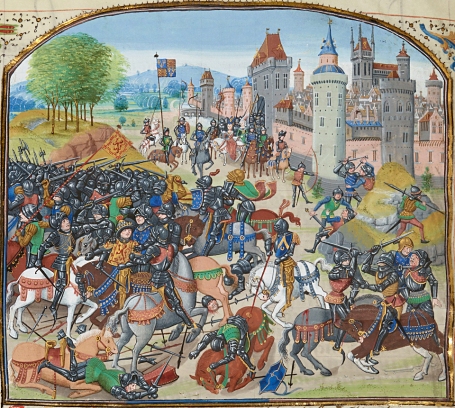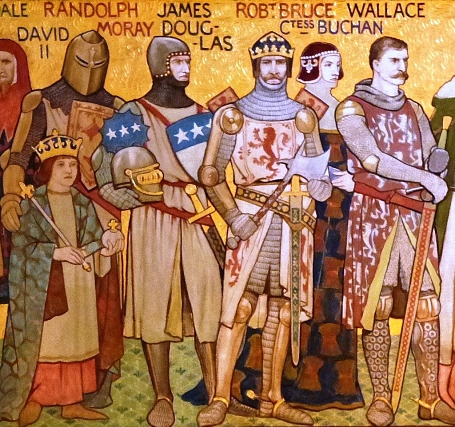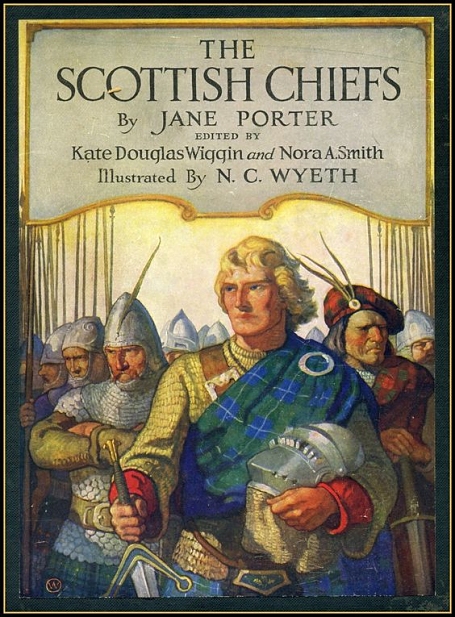The Life and Heroick Actions of the Renoun'd Sir William Wallace,
General and Governour of Scotland
by William Hamilton of Gilbertfield
Book X, Chapter IV
How Sir William Douglas won the Castle of Sanquhair by a Jeopardie: How WALLACE rescu'd him from the English and put them out of those Parts.
Sir William Douglas, as old Writers record,
Of Douglas-dale at this Time was the Lord.
By his deceased Lady he had now
Two likely Sons, for Strength and Courage too.
Whose nat'ral Parts, all Greatness did presage,
When at the Schools, and but of tender Age.
In Knowledge that they might the more advance,
They're quickly sent to the best Schools in France.
Their Father, that most noble valiant Knight,
King Edward had detain'd against all Right:
Till with the Lady Ferres he'd conclude
A Match, which after prov'd not for his good.
Two Sons he had by this young Lady fair,
And then got leave for Scotland to repair.
Accordingly, his Lady, Sons, and he,
Came all to Douglass and lived Pleasantlie.
King Edward thought that he had stedfast been
To him, but Faith the Contrair soon was seen.
The old Scots Blood remained in him still,
Which to the English never bore good will.
That Time the Sanquhair was a Castle strong,
From which the Scots did suffer frequent wrong.
An English Captain did Command the same,
Was Bewford call'd, a Pox upon his Name.
To Douglas Lady was a Kinsman near,
From him no Harm on that account did fear.
But when Sir William saw Wallace in plain
Was likely to free Scotland once again,
He, as a true Born Scots-Man, thought he should
Give all Assistance to him that he could.
To which a cheerfull Heart he ready found,
Being by Force to Edward only bound.
To Thomas Dickson, a young Man and bold,
His Inclinations then he quickly told:
How he design'd with all his Pow'r and Might
To frighten, and surprise the English Knight.
"I have," said Dickson, "a good Friend indeed,
John Anderson, who Fire-Wood does lead.
Unto the Castle, stout and true like Steel,
To him I'll go and all the Case reveal."
Into a Moment good Sir William then,
Prepared Thirty stout well chosen Men.
He told his Lady, to Dumfries he went,
To meet some English that had to him sent.
Then march'd till Night upon them fast did draw,
And in a Cleugh lurk'd by the Water Craw.
Dickson to Sanquhair goes and tarries not,
And with John Anderson makes up a Plot,
That he should take John's Horses and his Weed,
By it was Day, a Draught of Wood to lead.
John was a cliver and auld farrand Boy,
As you shall hear by the ensuing Ploy.
Mean Time, good Anderson unto him told,
Ingenously the whole Strength of the Hold:
"Fourty they are, all Men of great avail,
Be they on Foot, they'll sorely you Assaill,
But if you chance the Entry for to get,
A great Pole-Ax on your right Hand is set:
Which may defend you stoutly in the Throng
Be Douglas wise he'll not stay from you long."
Then Anderson, the Ambush by and by,
Near to the Castle led most privately.
Dickson is with the draught of green Wood gone,
Who to the Castle whisling came anon,
Array'd in Anderson's old rural Weed,
To whom the Porter opened with Speed.
Who said, "This Hour thou might have stay'd away,
Thou art untim'ous, for its scarcely Day."
Dickson his Draught got in by lucky Fate,
Then cut the Cords, and all fell in the Gate.
The Porter twice out o'er the Head he Struck,
And kill'd him dead – prodigious good Luck.
The Ax he got, whereof his good Friend spoke,
And gave a Sign, whereat the Ambush broke.
The ballad, The Life and Heroick Actions of the Renoun'd Sir William Wallace, General and Governour of Scotland, by William Hamilton of Gilbertfield, 1722, is in the public domain.

The Kingdom of England and the Kingdom of Scotland fought dozens of battles with each other. They fought typically over land, particularly Berwick-Upon-Tweed, and the Anglo-Scottish border frequently changed as a result. Read more at Wikipedia.

The First War of Scottish Independence was the initial chapter of engagements in a series of warring periods between English and Scottish forces lasting from the invasion by England in 1296 ... Read more at Wikipedia.

Digitized version of The Scottish Chiefs, by Jane Porter, a novelization published in 1921 by Charles Scribner's Sons, about William Wallace and the First Scottish War of Independence. Read online at archive.org.